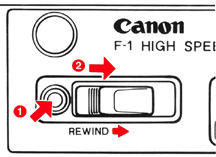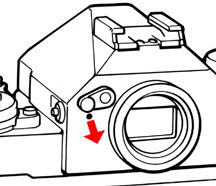| Exposure |

1 ) Compose the picture so that the subject is covered by the metering area.
2) Focus the subject.
3) Press the shutter button halfway to turn on the meter. The aperture will close
down to the f/stop set on the apertute ring (stopped down metering). Note: See
metering area information.
Turn the aperture ring until the meter needle aligns with the center of the metering
index (correct exposure). If the meter needle does not align with the index, turn
the shutter dial until it does. The shutter speed appears below the metering information
window.
- The width of the index is equivalent to one-half f/stop
- The red areas above and below the metering information window indicate the out-ofmeter-coupling range.
- Note: Since this camera uses a pellicle mirror, metering with a linear type polariaing filter attached is NOT possible.
- Further, when metering with an independent exposure meter, add 0.8 f/stop (about 1 f/stop) to the metering value to compensate for the reflectance of the pellicle mirror.
Eyepiece Shutter
| Since this camera uses a half-mirror instead of the fully reflecting mirror, if your eye will not be at the eyepiece during shutter release, close the eyepiece shutter to prevent stray light from entering. To do this, turn the eyepiece shutter lever in the direction of the arrow. |
|
Exposure compenstion
[1] Quick exposure
compenstion is possible by using the exposure compensation scale in the viewfinder.
The scale above the metering index indicates overexposure and the scale below it
indicates underexposure. One graduation is equivalent to one f/stop.
[2] Exposure compensation using the dial on the top of the camera is also possible.
To make a correction, turn the dial while pressing the lock release button, until
the desired correction aligns with the index.
• The whole numbers are for increasing exposure while the fractions are for reducing exposure. The numbers '`2" and "1/2" are equivalent to one f/stop (or one step of the shutter dial) while "4" and "1/4" are equivalent to two fistops (or two steps of the shutter dial). The intermediate settings indicate increments of 1/3 of an f/stop. |
|
Note: It is possible to correct exposure up to +5 f/stops by using both the exposure compensation dial on the top of the camera and the exposure compensation scale in the viewfinder at the same time.
| Rewinding the Film |
Rewind the film
immediately after the warning lamp lights and the frame counter reaches "0".
Power Rewinding
1 ) While pressing the lock release button, slide the power rewind switch in the
direction of the arrow. The motor will stop automatically as soon as power rewinding
finishes.
2) Press the lock release button. The power rewind switch will return to its original
position and the warning lamp will go out.
Note: After power rewinding,
all film will be rolled up into the cartridge.
 |
Manual Rewinding |
Previous | Next | Index Page
Back to Canon New F-1 Site
| Back | To Main Index Page
| Back | To Main Index Page of Canon New F-1 WebSite
Its Concept, Its System
Metering Options, Viewfinders, Exposures Control, Reliability Issues,
Shutter Mechanism; Motor Drives/Winder, Data Film
backs,
Flash photography, Focusing Screens, Macro/Close-up,
Remote photography.
Canon FD & FDn Lenses.
| Message Board |
for your New Canon F-1 SLR camera(s)
| Message Board | for your Canon optics
in a shared environment
| Message Board | Specifically for Dispose or Looking for Canon Photographic
equipment
Main Reference/Layout Map for body: HTML | PDF (471k)
Specifications: HTML | PDF (58k)
Instruction Manual: Canon New F-1 Camera | Motor Drive FN | Canon High Speed Motor Drive Camera |
Home - Photography in Malaysia |
Copyright © 2000. leofoo ®. MIR Web Development Team.
Credit: Mr Richard Yeow, General Manager of camera and video division, Canon Marketing, Malaysia and Tony Kano, for being so supportive and granting permission to use some of the original content of Canon; Mr Philip Chong for patching some mistakes made earlier in this site. Made with a PowerMac, Broadcating with a RedHat Linux Server.

